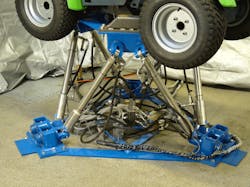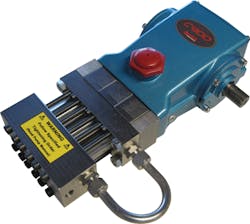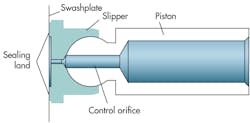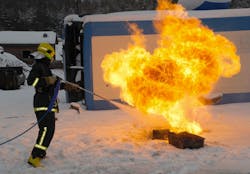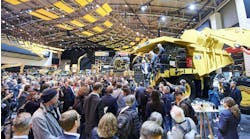Water Hydraulics Pushes Into High-Pressure Systems
Water was the first fluid ever used as a power transmission medium — the earliest water-hydraulics applications date to 2,000 years ago. Of course, modern water-hydraulic systems differ greatly from historical applications, thanks to an influx of new design, material, and control technologies.
The 1990s saw many countries around the world devote extensive research and development toward water hydraulics. R&D cooled somewhat at the onset of the new millennium, but it’s bouncing back due to rising concerns about the environment and global climate change.
Sustainability
Questions surround the sustainability of water hydraulics technology. It hinges on two main factors: pressure-medium life cycle and energy efficiency. When comparing sustainability of various pressure-medium alternatives, all processes related to the supply chain must be considered. For example, in the oil industry, this means all processes related to drilling the oil, transportation, refining, marketing, delivery, usage and disposal.
In this case, the comparing supply chains for oil against water reveals stark differences. Water is more readily available, and it requires minimal purification and treatment processes. Oil’s supply chain, on the other hand, is long, requires significant capital investments, and presents an environmental hazard. Furthermore, oil must be packed into barrels, containers, cans, etc., while water is usually available from the tap.
On the other hand, microbiological growth becomes concern in water-hydraulic systems, adding costs for maintenance and service. Antimicrobial additives can prevent microbial growth, once again adding to overall cost. Still, the cost benefits of easy storage and less frequent fluid changes outweigh the negatives.
Comparison of oil and water in terms of overall energy efficiency is somewhat more complex. Water hydraulics uses stainless steel and similar materials to resist corrosion of components. Furthermore, certain design features can be complicated to manufacture, and small production quantities increase energy consumption of production per produced component. On the flip side, water undergoes lower pressure losses than oil, which is a major benefit for efficiency, especially with large flows and long pipes.
A system’s basic design and control principle also plays a big role in energy consumption. Unlike oil hydraulics, water hydraulics must rely on different methods to improve overall system efficiency due to the limited availability of variable-displacement pumps and limited controller options.
The easiest solution is to use unloader and relief valves just like those employed in oil hydraulics (before variable-displacement pumps became commonplace for oil-based systems). In some cases, the ever-improving controllability of modern ac variable-frequency drives makes it possible to use pump-speed control to achieve the control functions derived from variable-displacement pumps in oil hydraulics. One future option involves the application of digital hydraulics technology to achieve accurate and fast load-control tasks with optimized energy consumption.
Market Study Revelations
Students at Tampere University of Technology (TUT), Finland, conducted an international market survey of water-hydraulics component and system manufacturers in the spring of 2013. Despite the rather narrow sample size, it revealed developing trends within the water-hydraulics market. For instance, 75% of the respondents said water-hydraulics sales have been increasing over the last five years, and 87.5% expect further growth during the next five years. This is good news, considering the development of the whole technology area.
What is the most important reason for using water hydraulics? The number one answer was safety (fire resistance), for people and the environment. Therefore, Europe, Asia, and the U. S. stand to gain the most by more widespread use of water hydraulics. Additional responses indicate a nearly even split between use of HF-A solutions and pure water systems as the most prevalent. However, many pure water systems are of the open high-pressure variety, which significantly affects distribution. Meanwhile, HF-A systems dominate for power transmission applications.
In terms of power, system deliveries distributed quite evenly from 10 kW to more than 100 kW. However, power rating of systems was somewhat concentrated at both extremes, with fewer falling within the 50âkW range. Lower-power systems tend to operate within a pressure range of 50 to 160 bar, whereas higher power systems operate at pressures exceeding 300 bar.
What improvements are needed? Respondents wished to see developments to improve control valves, materials, seals, and reliability, as well as to reduce manufacturing costs. More than 70% of the responding companies plan to put more effort into product development in the future.
What is the top application for water hydraulics? The metal industry ranked number one (50%), with water treatment, mining, and the oil and gas industry also well represented.
One of the more common water-hydraulic applications today is the waterjet cutting system for the paper industry, where open-end systems cut paper lines in paper machines. Typical pressures range from 800 to 1,500 bar, and flows from about 1 to 5 lpm.
Figure 1 shows a direct-drive triplex pump developed by Hytar Oy. It has 900-bar maximum pressure with a flow rate of 4.7 lpm at 1,200 rpm. It suits hydrostatic pressure testing, medium-pressure waterjet cutting, and high-pressure washing systems. The pump can be used with pure water and low viscosity fluids with 40-μm filtration. Rotational speeds range from 100 to 1,200 rpm continuous; 0 to 1,500 rpm temporary.
One clear trend has emerged within the world of water hydraulics and its development during the decades: a division between open systems using pure water and closed power-transmission systems that use HFA fluid or other water-based fluids. This has given rise to the term high-pressure water systems or solutions — and with justification.
Most of today’s high-pressure water pumps are in-line piston units driven by an oil-lubricated crankshaft mechanism. Much less available are water-lubricated pumps usually of axial-piston design with a rotating cylinder group and fixed swashplate.
Because of water’s limitations as a pressure medium, water lubricated axial-piston pumps often are complicated to design and manufacture. Nonetheless, certain features and characteristics of axial-piston pumps become assets for water-hydraulics applications, namely high efficiency and high power density.
Variable-displacement axial-piston pumps for water hydraulics are quite scarce. The Water Hydraulics Co. Ltd., Hull, England (bit.ly/1eOphW3), the lone manufacturer of these pumps, offers only two displacements (70 and 225 cm3/rev). This limits applicability of water hydraulics, especially in higher-power applications that would have to sacrifice overall system efficiency because of the limited pump controllability.
The key issue surrounding water lubricated axial-piston pumps concerns the design of, and materials used for, various water-lubricated sliding interfaces inside the pump. The most recent comprehensive study related to this area comes from a dissertation provided by Dr. Markus Rokala. In his dissertation, Rokala focused on slipper behavior during operation, slipper behavior during swashplate turning, and especially the impact of the slipper deformations in water-hydraulics axial-piston pumps.
Rokala’s goal was to find methods that achieve a higher power density for axial-piston pumps in water-hydraulic systems. This meant better components were needed to widen the range of applications for water hydraulics. He studied two different basic structures of slippers with different material combinations. He found that slipper behavior can be predicted with sufficient accuracy using a simulation model. This model was based on fluid structure interaction calculations, basic theory, and measurements.
ultrahigh-pressure systems
The hydraulically driven pressure-intensifier pump is the predominant pump technology in ultrahigh-pressure applications, such as water-jet cutting, or in demanding environments, especially for transfer-barrier pumps used the steel and forging industries. It’s also become a popular choice for mobile high-pressure water systems, such as high-pressure cleaning applications, dust suppression, and hydrodemolition. Furthermore, it’s proven to be a versatile technology for mobile applications, as evidenced by water hydraulic pumps from Dynaset Oy, Ylöjärvi, Finland (bit.ly/1aOAuX6).
Most of today’s pressure intensifiers are of the reciprocating type, featuring dual water pistons. Some multiple-piston rotating units also are available. Perhaps their biggest advantage is simple construction. On top of that, power-to-weight and volume ratios and efficiency can be very lucrative in spite of the oil hydraulic primary drive. Oil hydraulic primary drives offer some advantages in control, such as power control and load sensing, something not typically found in water-hydraulic systems.
Digital Water Hydraulics
Digital hydraulics offers another way to achieve different controls in fluid power. Lots of research has gone into the implementation of digital hydraulics in oil hydraulics, but it’s also suitable for water hydraulic systems. In fact, about 15 years ago, TUT first ran into digital (discrete) controls when researching low-pressure water hydraulics. Digital hydraulics helps further the cause of water hydraulics because it replaces proportional and servovalves, which are costly, and it’s difficult to find what you need.
The most basic approach is to use simple three or five-state controls with multiple on-off valves. Precision controls with greater complexity can be established by including more-sophisticated control algorithms and more valves. However, no valves are available yet, particularly for digital water hydraulics, thus restricting system design to whatever valves can be found in the market.
Water systems could benefit greatly from the design of a digital control unit. Research has proven that digital control increases the controllability of water systems.
KARE T. KOSKINEN is professor, and Jussi Aaltonen, project manager, both with the Department of Mechanical Engineering and Industrial Systems at Tampere University of Technology, Finland.
Water QualityThree types of contamination define water quality in closed water-hydraulics systems: biological, chemical, and physical. Biological contamination means microbial growth in the system, both in the fluid and on wetted surfaces. Chemical contamination refers to changes in water chemistry caused by contaminants dissolving in the fluid or reacting with it. Physical contamination involves wear particles and other particulate debris in the system. Nutrition concentration in the fluid mainly determines the growth rate of bacteria in water-hydraulics systems. No doubt, then, that the best way to avoid problems with microbial growth is to keep the nutrient level as low as possible. However, microbiological growth is not as big an issue in open-end systems. Experiments on water-hydraulics systems revealed that biological, chemical, and physical contamination can be kept to acceptable levels to secure reliable machine operation. However, experiments and experience also exposed their strong interconnections and combined effects. For example, it’s challenging to decipher the combined effect of particles and biofilm in a filter. Filters typically possess the so-called bioreactor effect, i.e., a large surface area together with low flow velocity and suitable temperature promotes an environment for microbes to reproduce in the filter cartridge. This surface growth affects the filtration ratio and pressure difference over the cartridge, and the other hand-contaminant particles entrapped by the filter may contain suitable nutrients for microbes. |

